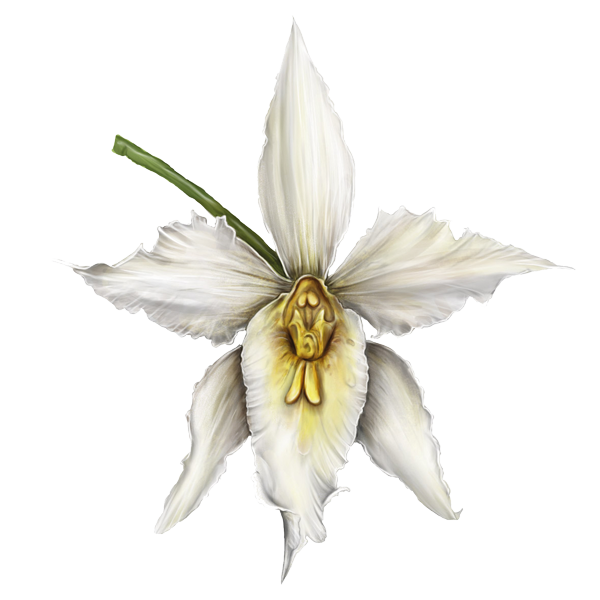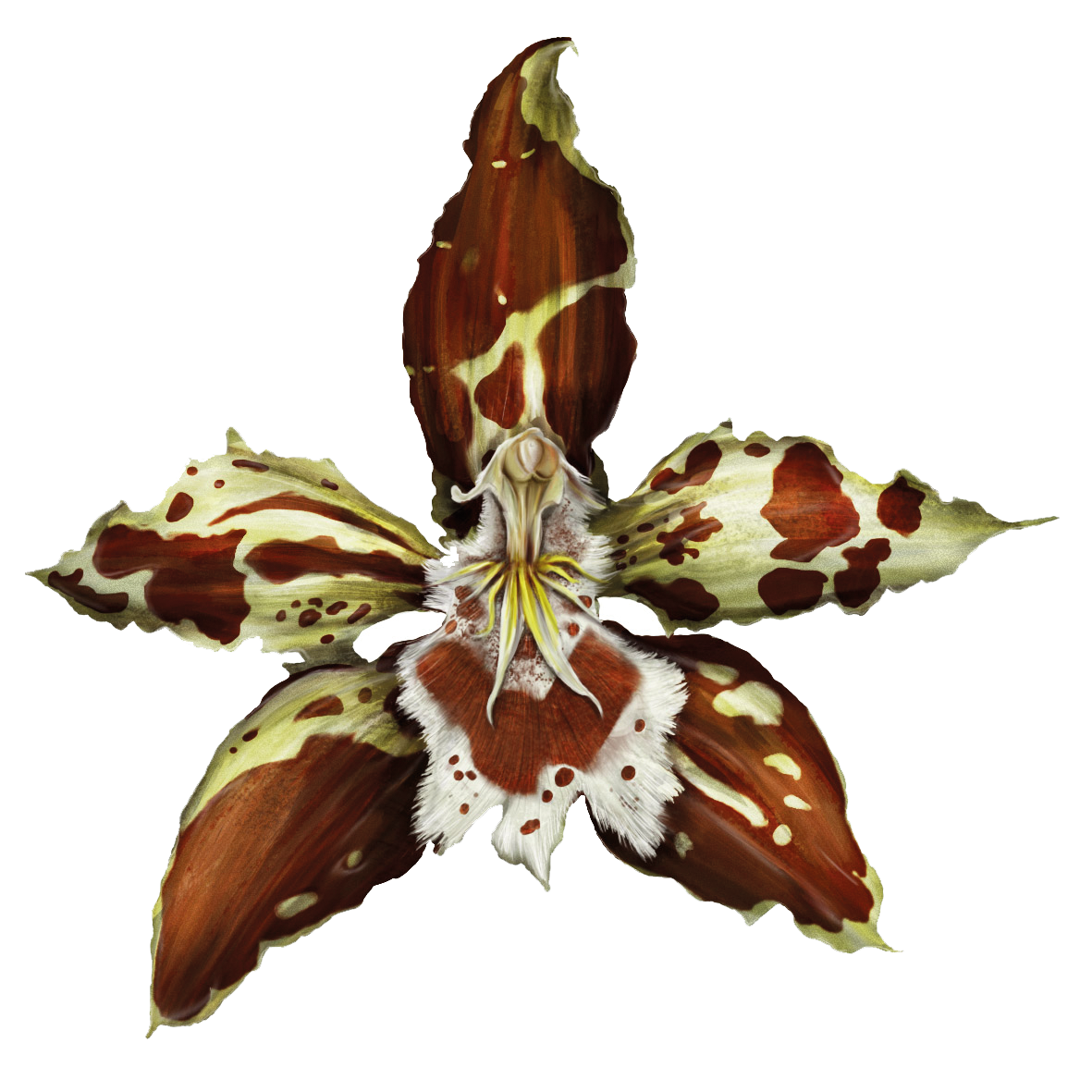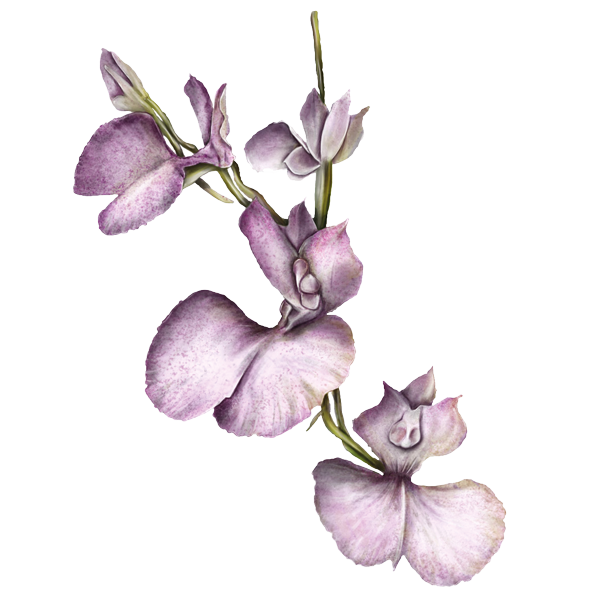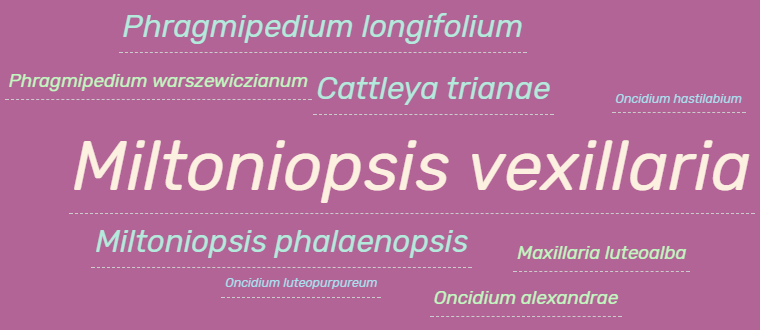Information file: 401
Diversity of Orchids in Cundinamarca
An opportunity for sustainable use
Carolina Castellanos ▶
Cristian Castro ▶
Yissel Rivera ▶
Martha Vallejo ▶
Diana López ▶
Diana Lara ▶
The high species richness of orchids in the state of Cundinamarca and their historical use as decorative plants represents an opportunity to create alliances of preservation, research, and sustainable use.
▲ Continue ▼
Some native orchids recorded in Cundinamarca

Curled Odontoglossum
Scientific name: Odontoglossum crispum
Endangered
Distribution: 1,700 to 2,700 m a.s.l. Cundinamarca, Boyacá, Caquetá, Cauca, Huila, Nariño, Santander, Tolima, and Putumayo.
Open in "SiB Colombia"

Yellow-purple odontoglossum
Scientific name: Oncidium luteopurpureum
Near Threatened
Distribution: 2,000 to 2,800 m a.s.l. Cundinamarca, Antioquia, Boyacá, Tolima, Caldas, Huila, Risaralda, Santander, Valle del Cauca, Cauca, Putumayo, and Quindío.
Open in "SiB Colombia"

Large Spurred Comparettia
Scientific name: Comparettia macroplectron
Least Concern
Distribution: 1,350 to 3,000 m a.s.l. Boyacá, Meta, Cundinamarca, Magdalena, and Casanare.
Open in "SiB Colombia"
Due to the beauty and variety of shapes, sizes, and colors of their flowers, orchids are one of the most charismatic group of plants. Therefore, they have historically been used for decoration.
The greatest diversity of orchids in the world can be found in the tropical mountains of the Andes. In Colombia, Antioquia is the state with greatest species richness, followed by Cundinamarca, which has 940 different species recorded for its territory (100 endemic) species1. However, the uncontrolled extraction of orchids for commercialization, combined with the destruction of forests and the replacement of natural areas for productive land covers, has made natural populations become scarcer. Until now, the conservation status of only 73 native species in Cundinamarca has been evaluated. 51 % (37 species) of these are under some threat category2. This situation evidences that there is an imminent need for both in situ and ex situ conservation actions that must be developed by the academia, NGOs, environmental authorities, and society at large.
In this sense, plant nurseries play an important role in holding and propagating those species that are under some threat category. Currently, the production and commercialization of orchids is done by such plant nurseries and merchandisers. According to data published by Convention on International Trade on Endangered Species of Wild Fauna and Flora (Cites)3, between 1975 and 2015, 189 orchid species native to the state of Cundinamarca have been traded, their major destinations being Germany, United States, and Japan.
Consequently, and with the purpose of generating synergies between knowledge and conservation to promote the sustainable use of orchids native to the state of Cundinamarca, the Humboldt Institute, Pontificia Universidad Javeriana (Pontifical Xaverian University), Jardín Botánico de Bogotá José Celestino Mutis (Botanical Garden of Bogotá José Celestino Mutis), and the Corporación Colombiana de Investigación Agropecuaria (Colombian Corporation of Agricultural Research) are developing a project that aims to contribute to research, technological innovation, and social appropriation of scientific knowledge in this topic. The project is financed by the Sistema General de Regalías (General System of Royalties) through the Secretaría de Ciencia, Tecnología e Innovación de la Gobernación de Cundinamarca (Secretariat of Science, Technology and Innovation of the Government of Cundinamarca).
Preliminary results show that in the municipalities of San Antonio del Tequendama, Fusagasugá, La Mesa, Mesitas del Colegio, Cachipay, Supatá, Tena, and Bogotá there are 57 plant nurseries that produce and commercialize 86 different species of orchids, of which 63 are naturally distributed in the state of Cundinamarca and 23 in other regions of Colombia.
This represents a great opportunity to encourage the sustainable use of native orchids as an alternative to the current commercialization of exotic species. It is also a chance to improve cultivation methods of native species, decrease periods of growth and flowering, reduce productions costs, strengthen capacities of workers, and receive support from authorities that may promote such activity in the region.
Major plant nurseries for orchids in Cundinamarca and number of recorded species
Species of orchids have been recorded in all the municipalities and altitudinal ranges of the country. Most species correspond to specimens found between 2,500 and 3,500 m a.s.l.
Most frequent native species in plant nurseries
Commercial exploitation of orchids originates in the 18th century, and there are records of numerous extractions directed to Europe.
◀ Continue ▼Number of records in biological collections between 1890 and 2016
In botanical collections of Cundinamarca there are specimens from 1962 to 2015. Most specimens were collected in the decade of 1960 and the first decade of the 21st century. Investigators such as Pedro Ortiz Valdivieso, M. Schneider, Juan Camilo Ordóñez, José Cuatrecasas, and Mariano Ospina have been the most significant contributors to these collections.
▲ Next ▶National scenario for orchids
In Colombia, there are 4,270 native species of orchids1, of which 1,572 are endemic and 207 are categorized under some threat category2 mainly due to habitat destruction and followed by extraction of wild populations for commercial motives. Orchids may be found in all of the territory, yet 77 % of species are found in the Andean region1 and are associated to Andean forests and paramos. Colombia currently has a National Plan1 that includes goals and guidelines to generate and expand knowledge, conserve, use sustainably, educate, and strengthen laws related to this group of plants by highlighting exploitation as a countrywide opportunity. Implementing the plan implies promoting the integration of local and regional initiatives so that activities currently being developed in Colombia may contribute to other initiatives in the country.
◀ ▶
In botanical collections of Cundinamarca there are specimens from 1962 to 2015. Most specimens were collected in the decade of 1960 and the first decade of the 21st century. Investigators such as Pedro Ortiz Valdivieso, M. Schneider, Juan Camilo Ordóñez, José Cuatrecasas, and Mariano Ospina have been the most significant contributors to these collections.
◀ ▶Species with most records in Cundinamarca

Herbarium records that are assumed to be of wild individuals, although some may correspond to cultivated individuals.
◀ Continue ▼
Keywords
Biological collections Threatened speciesEndemic species Economic development
Biodiversity Tools in Urban Planning
International Cooperation in the Environmental Sector
▲

 PDF version
PDF version Methods (in Spanish)
Methods (in Spanish)  References
References Share
Share